

Chilling effect. In a legal context, a chilling effect is the inhibition or discouragement of the legitimate exercise of natural and legal rights by the threat of legal sanction.[1] The right that is most often described as being suppressed by a chilling effect is the US constitutional right to free speech.
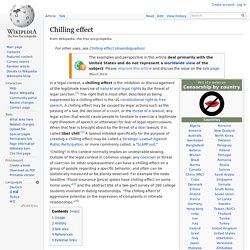
A chilling effect may be caused by legal actions such as the passing of a law, the decision of a court, or the threat of a lawsuit; any legal action that would cause people to hesitate to exercise a legitimate right (freedom of speech or otherwise) for fear of legal repercussions. When that fear is brought about by the threat of a libel lawsuit, it is called libel chill.[2] A lawsuit initiated specifically for the purpose of creating a chilling effect may be called a Strategic Lawsuit Against Public Participation, or more commonly called; a "SLAPP suit.
" "Chilling" in this context normally implies an undesirable slowing. Usage[edit] History[edit] Strategic lawsuit against public participation. Transcranial magnetic stimulation. Background[edit] Early attempts at stimulation of the brain using a magnetic field included those, in 1910, of Silvanus P.
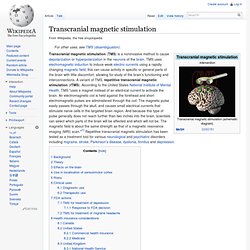
Thompson in London.[2] The principle of inductive brain stimulation with eddy currents has been noted since the 20th century. The first successful TMS study was performed in 1985 by Anthony Barker and his colleagues at the Royal Hallamshire Hospital in Sheffield, England.[3] Its earliest application demonstrated conduction of nerve impulses from the motor cortex to the spinal cord, stimulating muscle contractions in the hand. Broken windows theory. The broken windows theory is a criminological theory of the norm-setting and signalling effect of urban disorder and vandalism on additional crime and anti-social behavior.
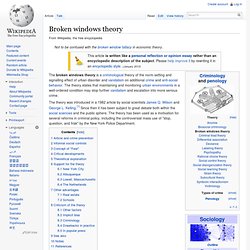
The theory states that maintaining and monitoring urban environments in a well-ordered condition may stop further vandalism and escalation into more serious crime. The theory was introduced in a 1982 article by social scientists James Q. Wilson and George L. Kelling. Since then it has been subject to great debate both within the social sciences and the public sphere.
Article and crime prevention[edit] The broken windows theory was first introduced by social scientists James Q. Consider a building with a few broken windows. Before the introduction of this theory by Wilson and Kelling, Philip Zimbardo, a Stanford psychologist, arranged an experiment testing the broken-window theory in 1969. Smells like clean spirit. Nonconscious effects of scent on cognition and behavior. Net neutrality. Net neutrality (also network neutrality or Internet neutrality) is the principle that Internet service providers and governments should treat all data on the Internet equally, not discriminating or charging differentially by user, content, site, platform, application, type of attached equipment, and modes of communication.
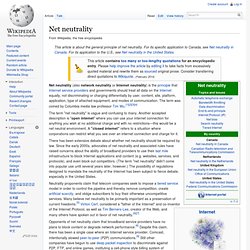
The term was coined by Columbia media law professor Tim Wu.[1][2][3][4] The term "net neutrality" is vague and confusing to many. Another accepted description is "open internet" where you can use your internet connection for anything you wish at no additional charge and with no restrictions—this would be a net neutral environment. A "closed internet" refers to a situation where corporations can restrict what you see over an internet connection and charge for it. There has been extensive debate about whether net neutrality should be required by law. Definitions[edit] Absolute non-discrimination Limited discrimination without QoS tiering Limited discrimination and tiering.
Bandwidth throttling. Bandwidth throttling is the intentional slowing of Internet service by an Internet service provider.

It is a reactive measure employed in communication networks in an apparent attempt to regulate network traffic and minimize bandwidth congestion. Bandwidth throttling can occur at different locations on the network. On a local area network (LAN), a sysadmin may employ bandwidth throttling to help limit network congestion and server crashes.
On a broader level, the Internet service provider may use bandwidth throttling to help reduce a user's usage of bandwidth that is supplied to the local network. Operation[edit] Clients will make requests to servers, which will respond by sending the required data. In order to prevent such occurrences, a server administrator may implement bandwidth throttling to control the number of requests a server responds to within a specified period of time. Application[edit] Network neutrality[edit] Throttling vs. capping[edit] Court cases[edit] Comcast Corp. v. How to Burst the "Filter Bubble" that Protects Us from Opposing Views.
The term “filter bubble” entered the public domain back in 2011when the internet activist Eli Pariser coined it to refer to the way recommendation engines shield people from certain aspects of the real world.
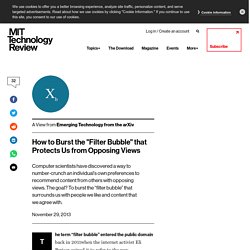
Pariser used the example of two people who googled the term “BP”. One received links to investment news about BP while the other received links to the Deepwater Horizon oil spill, presumably as a result of some recommendation algorithm. This is an insidious problem. Much social research shows that people prefer to receive information that they agree with instead of information that challenges their beliefs. This problem is compounded when social networks recommend content based on what users already like and on what people similar to them also like. This is the filter bubble—being surrounded only by people you like and content that you agree with.
And the danger is that it can polarise populations creating potentially harmful divisions in society. It’s certainly a start.